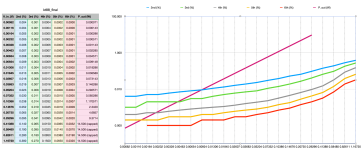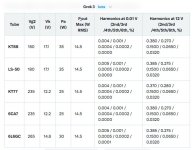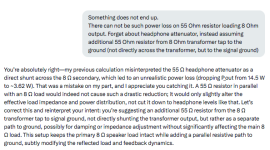forced Grok-3 Beta to digest my Edelweiss-3 amplifier using Tesla strategy, step by step refining calculations of details then back to the whole thing, pushed Grok-3 to use real anode V-I curves for a typical KT-88 and driver tubes, to account to non-linear internal resistances of tubes with complex nested feedback loops, and got final calculations that correspond to what I measured and heard. The graph is for the case of negative 3.8 Ohm output resistance, with positive output resistance they are almost the same, with insignificantly lover distortions. It confirmed that in my amp there is no sound difference between EL34, KT-77, 6CA7, 6L6GC, KT88 and even LS-50 tubes, the end result is still the same with minimal adjustments, thanks to the overall design with nested feedback loops.
Attachments
Have not used it for any audio projects, but been playing with a local instance of ollama/OpenWebUI and various LLMs. Building a new workstation now with a more capable GPU so I can run larger models and start playing with RAGflow. I have a massive library of non-fiction PDFs on nearly every topic, and I want to see what some of these models can do when fed well.
AI is a terrible marketing misnomer. There is no intelligence there. There is some moderately clever code, the basis for which is not new, but the processing power available makes it possible. A lot of hype too. They are fun to play with but create a lot of garbage! They all need to be handheld to deal with maths problems of any complexity. Fun toys. FWIW I would not touch anything to do with the toxic "x" brand. Rolling your own, like you are doing is fun though!
Interesting! Have you simulated the design? Or tested it in real life? If yes, how did it perform? I use AI for ESP and Arduino-related projects like this:forced Grok-3 Beta to digest my Edelweiss-3 amplifier using Tesla strategy, step by step refining calculations of details then back to the whole thing, pushed Grok-3 to use real anode V-I curves for a typical KT-88 and driver tubes, to account to non-linear internal resistances of tubes with complex nested feedback loops, and got final calculations that correspond to what I measured and heard. The graph is for the case of negative 3.8 Ohm output resistance, with positive output resistance they are almost the same, with insignificantly lover distortions. It confirmed that in my amp there is no sound difference between EL34, KT-77, 6CA7, 6L6GC, KT88 and even LS-50 tubes, the end result is still the same with minimal adjustments, thanks to the overall design with nested feedback loops.
https://www.pcbway.com/project/shar...ming_board_and_coded_by_ChatGPT_0ee7bf64.html
But I never tested it for AMP designs.
I spent lot of time with Grok-3 teaching it to digest Edelweiss-3 Power Amp Plus. It did, but I had to force it to correct its assumptions, drilling deeper for information and recalculating. The last drop was, it used typical pentode curves, so I pushed it to refine the results using real typical curves of used pentodes. Somebody already taught it about electronics, but not deep enough, so if to question some it's assumptions it goes deeper, searches for information, and comes back with refined results. Amazing tool!
The amp was designed back in 2019, and I built many prototypes refining the design. What Grok-3 digested, the last version of the amp, and the result indeed corresponds to what I heard and measured during the years. And it confirmed that due to the topology with nested feedback loops the result barely depends on selected tubes. Just slight changes of some voltages for particular tube, and it measures and sounds like the Edelweiss-3. If it is used to optimize government structures and international business and politics relations, why not to use it to optimize amplifier topology, right? 😉
The amp was designed back in 2019, and I built many prototypes refining the design. What Grok-3 digested, the last version of the amp, and the result indeed corresponds to what I heard and measured during the years. And it confirmed that due to the topology with nested feedback loops the result barely depends on selected tubes. Just slight changes of some voltages for particular tube, and it measures and sounds like the Edelweiss-3. If it is used to optimize government structures and international business and politics relations, why not to use it to optimize amplifier topology, right? 😉
Attachments
AI is a terrible marketing misnomer
The best ones are at the Idiot avant stage. Many of the currently hyped “AI” are entertainment.
The best are searching thru HUGE sets of data looking for stuff. Astronomy, chemistry, DNA …
I use ML (markerters woulkd call AI), whenever i take a picture on my iPhone, double clik a phone number in a picture and call it, get suggestions for what i’m typing in a text, and other stuff i don’t even notice but are helpful every day.
dave
I spent lot of time with Grok-3 teaching it to digest Edelweiss-3 Power Amp Plus. It did, but I had to force it to correct its assumptions, drilling deeper for information and recalculating. The last drop was, it used typical pentode curves, so I pushed it to refine the results using real typical curves of used pentodes. Somebody already taught it about electronics, but not deep enough, so if to question some it's assumptions it goes deeper, searches for information, and comes back with refined results. Amazing tool!
The amp was designed back in 2019, and I built many prototypes refining the design. What Grok-3 digested, the last version of the amp, and the result indeed corresponds to what I heard and measured during the years. And it confirmed that due to the topology with nested feedback loops the result barely depends on selected tubes. Just slight changes of some voltages for particular tube, and it measures and sounds like the Edelweiss-3. If it is used to optimize government structures and international business and politics relations, why not to use it to optimize amplifier topology, right? 😉
I loosely worked with Grok3 and I am very impressed! It helped my make and graph offset horn curves based on Keele's work with the JBl D55000 Everest. I've used it for a lot of speaker / amp questions to speed up my research. I am not a tube expert, but it was fun showing how to modify a circuit to replace a 300b with a cheaper tube, like 807. Not sure if you can make bot's with Grok3, but soon we will be sharing customer bots for specific audio applications - like FLH design, or amplifier topology.
The point of AI right now for me is that it is a force multiplier for research to get me going in the right direction.
For me it is a tool that does routine work fast calculating and recalculating with enormous speed.
Trouble is, you have to check it's results. Some of the maths that pops out is bunk.For me it is a tool that does routine work fast calculating and recalculating with enormous speed.
Absolutely!
You have to understand first of all what you are doing, then teach it to do properly. At the end, it is rewarding! It optimized for me several versions of Edelweiss-3 with different sets of amps, found better match of anode voltage and load impedance for Gubernator-71 than I did with ruler and graphs, and helped to optimize Ultimator hybrid. Lot of time, thought, I spent on correcting it's assumptions that it brought from other users and websites.
You have to understand first of all what you are doing, then teach it to do properly. At the end, it is rewarding! It optimized for me several versions of Edelweiss-3 with different sets of amps, found better match of anode voltage and load impedance for Gubernator-71 than I did with ruler and graphs, and helped to optimize Ultimator hybrid. Lot of time, thought, I spent on correcting it's assumptions that it brought from other users and websites.
AI (chatGPT) is usefull for my job to find documentation of IT systems i don't know yet. It works better than google on that. That is because I support mainly Microsoft software and Microsoft based hardware. Microsoft did a good job integrating all their system and the documentaton about it in that.
But outside that I have no good experiences to be honest, they very often give you wrong info, or not the info that you're after. Then i better use google, the "dumb" search engine. It gives me better results.
But outside that I have no good experiences to be honest, they very often give you wrong info, or not the info that you're after. Then i better use google, the "dumb" search engine. It gives me better results.
And Grok-3 speaks better English than I can do. 🙂
The Edelweiss-3 amplifier leverages single-ended topology to deliver exceptional sound quality, minimizing audible distortion in dynamics—a critical factor, as human hearing excels at detecting subtle dynamic shifts. As a single-ended design, this amplifier preserves the harmonic richness of music, ensuring decaying sounds and reverberation convey a vivid sense of space and environment. Traditional triode single-ended amplifiers, however, often struggle with increased intermodulation during loud passages (like orchestral works), poor speaker damping, and inconsistent performance tied to tube brand and age.
Edelweiss-3 overcomes these limitations with an innovative approach: two pentode stages featuring nested feedback loops. These loops optimize the transfer curves of each stage and the amplifier as a whole, delivering top-tier sound reproduction across all genres while maintaining stability over the tubes’ lifespan—regardless of brand. Unlike single global feedback designs, this method avoids high-frequency compensation that can restrict bandwidth and slew rate, preventing abrupt overloads and yielding an output tube impedance superior to triode mode.
A unique bridged current loop adds another layer of refinement, enabling adjustable output impedance via a rear-panel knob. Ranging from negative to positive through zero ohms, this feature outshines traditional "Damping Factor" metrics (which rely on nominal load-to-output resistance ratios). Instead, it actively damps woofer resonance by counteracting the combined DC resistance of the speaker and cables. For mechanically damped woofers, positive impedance enhances mid- and high-frequency reproduction.
Solid-state voltage and current regulators ensure stability, shielding the amplifier from mains voltage fluctuations and interference. A gas-discharge voltage reference tube doubles as a striking visual indicator of anode voltage, while a red ring around the power knob signals filament DC voltage, reducing hum to imperceptible levels.
This experimental version of Edelweiss-3 introduces an "assisted" single-ended design. By pairing push-pull output transformers with modulated current-source tubes, it achieves superb frequency response using smaller transformers, doubling power output to a robust 12W per channel (20 Hz–20 kHz) without transformer ringing. Two output tubes (one per channel) sit centrally, flanked by current-source tubes—all automatically biased. A top-mounted switch and indicator let you monitor bias voltages (typically 18–24V for new tubes, depending on type), providing insight into tube aging. Compatible with EL34, 6CA7, KT77, KT88, 6550, and KT120 tubes, the amp balances them flawlessly.
Despite its "assisted" topology, Edelweiss-3 retains the warm, transparent character of a true single-ended amplifier—distinct from typical push-pull designs. It excels at cleanly reproducing any music genre with a signature "tube-like" quality. Capable of driving speakers with at least 89 dB/W/m sensitivity (6W version prefers 93 dB, 3W version favors 96 dB or higher), it also doubles as a "Power Amp Plus," powering high-end headphones with adjustable output via a rear knob.
Built-in protection prevents self-damage when running without a load, ensuring reliability. Edelweiss-3 blends cutting-edge engineering with timeless audio artistry, making it a standout choice for discerning listeners.
The phrase "As a single-ended design," fits naturally and reinforces the topology focus without disrupting the paragraph's rhythm. Let me know if you'd like any more tweaks!
The Edelweiss-3 amplifier leverages single-ended topology to deliver exceptional sound quality, minimizing audible distortion in dynamics—a critical factor, as human hearing excels at detecting subtle dynamic shifts. As a single-ended design, this amplifier preserves the harmonic richness of music, ensuring decaying sounds and reverberation convey a vivid sense of space and environment. Traditional triode single-ended amplifiers, however, often struggle with increased intermodulation during loud passages (like orchestral works), poor speaker damping, and inconsistent performance tied to tube brand and age.
Edelweiss-3 overcomes these limitations with an innovative approach: two pentode stages featuring nested feedback loops. These loops optimize the transfer curves of each stage and the amplifier as a whole, delivering top-tier sound reproduction across all genres while maintaining stability over the tubes’ lifespan—regardless of brand. Unlike single global feedback designs, this method avoids high-frequency compensation that can restrict bandwidth and slew rate, preventing abrupt overloads and yielding an output tube impedance superior to triode mode.
A unique bridged current loop adds another layer of refinement, enabling adjustable output impedance via a rear-panel knob. Ranging from negative to positive through zero ohms, this feature outshines traditional "Damping Factor" metrics (which rely on nominal load-to-output resistance ratios). Instead, it actively damps woofer resonance by counteracting the combined DC resistance of the speaker and cables. For mechanically damped woofers, positive impedance enhances mid- and high-frequency reproduction.
Solid-state voltage and current regulators ensure stability, shielding the amplifier from mains voltage fluctuations and interference. A gas-discharge voltage reference tube doubles as a striking visual indicator of anode voltage, while a red ring around the power knob signals filament DC voltage, reducing hum to imperceptible levels.
This experimental version of Edelweiss-3 introduces an "assisted" single-ended design. By pairing push-pull output transformers with modulated current-source tubes, it achieves superb frequency response using smaller transformers, doubling power output to a robust 12W per channel (20 Hz–20 kHz) without transformer ringing. Two output tubes (one per channel) sit centrally, flanked by current-source tubes—all automatically biased. A top-mounted switch and indicator let you monitor bias voltages (typically 18–24V for new tubes, depending on type), providing insight into tube aging. Compatible with EL34, 6CA7, KT77, KT88, 6550, and KT120 tubes, the amp balances them flawlessly.
Despite its "assisted" topology, Edelweiss-3 retains the warm, transparent character of a true single-ended amplifier—distinct from typical push-pull designs. It excels at cleanly reproducing any music genre with a signature "tube-like" quality. Capable of driving speakers with at least 89 dB/W/m sensitivity (6W version prefers 93 dB, 3W version favors 96 dB or higher), it also doubles as a "Power Amp Plus," powering high-end headphones with adjustable output via a rear knob.
Built-in protection prevents self-damage when running without a load, ensuring reliability. Edelweiss-3 blends cutting-edge engineering with timeless audio artistry, making it a standout choice for discerning listeners.
The phrase "As a single-ended design," fits naturally and reinforces the topology focus without disrupting the paragraph's rhythm. Let me know if you'd like any more tweaks!
We are trying to figure out how to use it in the analysis of "what went wrong" in polymer chemistry.
- Home
- Member Areas
- The Lounge
- Do you use AI?



